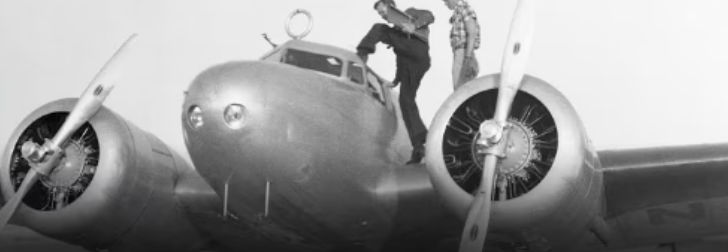New search effort aims to solve mystery of Amelia Earhart’s disappearance
- Replies 0
A fresh search effort has been announced in the long-running mystery of Amelia Earhart’s disappearance, nearly nine decades after she vanished without a trace.
Purdue University, which funded part of her historic 1937 flight and employed her as a counselor and adviser, is now backing a new expedition to uncover what could be her long-lost plane.
Researchers plan to travel to the remote island of Nikumaroro this fall, following new satellite imagery that suggests aircraft debris may be buried in the sand.
The image, captured in 2015 and resurfaced by Richard Pettigrew of the nonprofit Archaeological Legacy Institute, appears to show something resembling the tail and fuselage of Earhart’s Lockheed Electra 10E.
The object was spotted in a lagoon on Nikumaroro, part of the island nation of Kiribati, about 1,000 miles from Fiji.
“It satisfies all the criteria,” Pettigrew said, adding that its shape and composition match Earhart’s plane and that it's located near where several of her distress signals were believed to originate.
“Everything fits,” he insisted, but stopped short of calling it definitive. Purdue’s general counsel Steve Schultz said the university feels a duty to support the effort, both in honor of Earhart’s legacy and in pursuit of closure.

“We believe we owe it to Amelia and her legacy at Purdue to fulfill her wishes, if possible, to bring the Electra back to Purdue,” Schultz said.
Earhart’s plan before the flight was to return the aircraft to the university for study, something that’s only possible if it's located and recovered.
The first phase of the search is being funded by a $500,000 line of credit from the Purdue Research Foundation.
Researchers say the object became visible after a tropical cyclone in 2014 shifted sand on the island, briefly uncovering what Pettigrew believes could be the missing aircraft.
Also read: Mid-air mayhem: Passengers become unexpected heroes after the ceiling collapses on a flight
But since then, subsequent satellite photos show the area covered up again. Other clues previously discovered on Nikumaroro include American-made tools, a medicine vial, and, in 2017, forensic dogs that signaled the presence of human remains—though no bones were recovered.
Pettigrew acknowledges that the final piece of the puzzle is still missing: “What we lack now so far is what you call, what I call the smoking gun evidence.”
Not everyone is convinced by the renewed push. Ric Gillespie, who has led more than a dozen expeditions with the International Group for Historic Aircraft Recovery (TIGHAR), said his team has searched that exact spot and found nothing.
He believes the object is a tree root washed in by a storm. “We’ve looked there in that spot, and there’s nothing there,” Gillespie said, arguing that if Earhart’s plane is anywhere on Nikumaroro, it’s more likely buried under coral, not sand.
Also read: Why did a Tokyo-to-Houston flight make an emergency stop in Seattle? It wasn’t turbulence!
“The data, the facts, do not support the hypothesis. It’s as simple as that.” Despite doubts, the Purdue-led team will make a six-day boat journey to the island this November, followed by five days on-site to locate and assess the object.
If confirmed, further efforts would be made to recover the aircraft and return it to Purdue, where it could finally be studied as Earhart intended.
The pioneering aviator, who was the first woman to fly solo across the Atlantic, had worked at Purdue from 1935 until her disappearance in 1937. Her legacy has long outlived her flight—but her final chapter may still be buried beneath the Pacific.
Read next: Stunned passengers watch crew wrestle first-class passenger in mid-flight meltdown

Do you think this could finally be the breakthrough in one of history’s greatest aviation mysteries? Should more resources be committed to solving it, or is it time to move on from the search? Share your thoughts in the comments and let us know whether you believe the Electra is out there waiting to be found.
Purdue University, which funded part of her historic 1937 flight and employed her as a counselor and adviser, is now backing a new expedition to uncover what could be her long-lost plane.
Researchers plan to travel to the remote island of Nikumaroro this fall, following new satellite imagery that suggests aircraft debris may be buried in the sand.
The image, captured in 2015 and resurfaced by Richard Pettigrew of the nonprofit Archaeological Legacy Institute, appears to show something resembling the tail and fuselage of Earhart’s Lockheed Electra 10E.
The object was spotted in a lagoon on Nikumaroro, part of the island nation of Kiribati, about 1,000 miles from Fiji.
“It satisfies all the criteria,” Pettigrew said, adding that its shape and composition match Earhart’s plane and that it's located near where several of her distress signals were believed to originate.
“Everything fits,” he insisted, but stopped short of calling it definitive. Purdue’s general counsel Steve Schultz said the university feels a duty to support the effort, both in honor of Earhart’s legacy and in pursuit of closure.

New search effort aims to solve mystery of Amelia Earhart’s disappearance. Image source: BBC News / YouTube
“We believe we owe it to Amelia and her legacy at Purdue to fulfill her wishes, if possible, to bring the Electra back to Purdue,” Schultz said.
Earhart’s plan before the flight was to return the aircraft to the university for study, something that’s only possible if it's located and recovered.
The first phase of the search is being funded by a $500,000 line of credit from the Purdue Research Foundation.
Researchers say the object became visible after a tropical cyclone in 2014 shifted sand on the island, briefly uncovering what Pettigrew believes could be the missing aircraft.
Also read: Mid-air mayhem: Passengers become unexpected heroes after the ceiling collapses on a flight
But since then, subsequent satellite photos show the area covered up again. Other clues previously discovered on Nikumaroro include American-made tools, a medicine vial, and, in 2017, forensic dogs that signaled the presence of human remains—though no bones were recovered.
Pettigrew acknowledges that the final piece of the puzzle is still missing: “What we lack now so far is what you call, what I call the smoking gun evidence.”
Not everyone is convinced by the renewed push. Ric Gillespie, who has led more than a dozen expeditions with the International Group for Historic Aircraft Recovery (TIGHAR), said his team has searched that exact spot and found nothing.
He believes the object is a tree root washed in by a storm. “We’ve looked there in that spot, and there’s nothing there,” Gillespie said, arguing that if Earhart’s plane is anywhere on Nikumaroro, it’s more likely buried under coral, not sand.
Also read: Why did a Tokyo-to-Houston flight make an emergency stop in Seattle? It wasn’t turbulence!
“The data, the facts, do not support the hypothesis. It’s as simple as that.” Despite doubts, the Purdue-led team will make a six-day boat journey to the island this November, followed by five days on-site to locate and assess the object.
If confirmed, further efforts would be made to recover the aircraft and return it to Purdue, where it could finally be studied as Earhart intended.
The pioneering aviator, who was the first woman to fly solo across the Atlantic, had worked at Purdue from 1935 until her disappearance in 1937. Her legacy has long outlived her flight—but her final chapter may still be buried beneath the Pacific.
Read next: Stunned passengers watch crew wrestle first-class passenger in mid-flight meltdown
Key Takeaways
- Purdue University will send an expedition to Nikumaroro Island in November to search for Amelia Earhart’s missing plane.
- A satellite image captured in 2015 appears to show an object that may match the tail and fuselage of her Lockheed Electra 10E.
- Richard Pettigrew of the Archaeological Legacy Institute believes the object's shape, size, and location match where Earhart likely crash-landed.
- Skeptics, including veteran researcher Ric Gillespie, argue the image shows only a tree root and insist there is no solid proof the plane is there.






